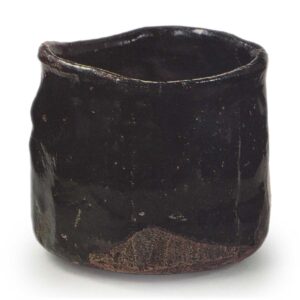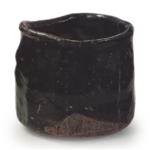
Setoguro, like Kizeto, did not appear suddenly in the Momoyama Period, but rather, it appeared on top of the traditional techniques that had been in place since the Muromachi Period. As already mentioned, since the Muromachi Period, many tenmoku tea bowls have been fired in Mino as in Seto. When these tenmoku bowls were fired, the bowls were drawn out for so-called “color viewing” in order to check the melting state of the glaze. Then the melted glaze must have suddenly come into contact with the cold outside air and produced a blackish glaze. This is the so-called Seto black glaze. Therefore, if we examine in detail the shards that have been discarded around Mino kilns since the Muromachi period, we are sure to find black drawers of Tenmoku tea bowls.
However, it was not until the so-called Seto black tea bowls were fired with a focus on such black glaze. It seems that it was around the Eiroku period at the end of the Muromachi period (1333-1573). Once I visited Mino and saw shards excavated from a kiln site called Nigane in Onada. The Setoguro style tea bowls excavated from there were rounded at the waist, and it is now assumed that this kiln was a smoking kiln in the late Muromachi period, from the astronomical period to the Eiroku period.
Setoguro means “black tea bowl” in Seto, but later came to be called Setoguro. The characteristic of Seto-kuro is its semi-short or cylindrical shape, and although the early works have a rounded waist as seen in the pieces excavated from the Nigane Kiln in Onada, it is thought that it was not until the Tensho period (1573-92) that it was completed with a clear and firm waist, and is therefore commonly called “Tensho kuro”. It is also commonly referred to as “Tensho black. It is glazed with iron, but its jet-black glaze is not the same as that of the original. This is the reason why it is also called “drawer black”.
Seto black tea bowls started in Onada, Mino, then spread to Asama, and finally to Oyaya, and the most outstanding works were fired in the kilns of Oyaya, and the famous tea bowls with the inscriptions “Obaraki,” “Obarame,” and “Winter Night” seem to have been fired in the Tensho period.
Although there are some modifications, such as adding a spatula to the body after wheel-thrown molding and slightly altering the mouth structure, many of them have a more elegant appearance than Shino and Oribe, which retain the overall appearance of wheel-thrown molding. Another characteristic of Setoguro is that the height of the base, which is almost always carved out, is made extremely low. The clay used is a slightly iron-enriched clay.
Setoguro is an extension of the traditional iron glaze of Kosedo, but the technique of drawing black to obtain a jet-black glaze was newly developed after the Tenbun period (1615-1644). Especially during the Keicho period, the shape of the potter’s shoes became more distorted, and the glaze technique also began to change, with feldspar glazes applied twice over black glazes to add variation to the glaze scene color. In the next stage, the black glaze is scraped off to show stripes or simple pictorial designs, and the black glaze is removed on one or both sides, and pictorial designs are painted with iron pigments on the removed base. Then, a white feldspar glaze was applied on top of it, and a tea bowl with decorative painted patterns, generally called “black Oribe”, was produced. Many of these bowls were quite elaborate, not only by applying different glazes, but also by scraping off the black glaze to show the design. It is likely that they were mass-produced from the middle of the Keicho period to the Genna period, and many of them remain.








